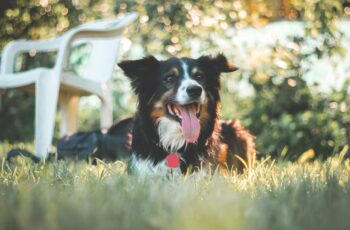Last updated:
Dogs come in all shapes and sizes. They have different faces, different length tails, and completely different coats. Some dogs have thin, short fur, while other dogs sport luxurious coats of thick curls.
Unless a Dachshund is curly-haired, it has barely-there fur, as do Chihuahuas. Golden retrievers have silky, longer, wavy fur. But their fur can’t compare to the long manes of the Afghan Hound, or the thick coat of a Saint Bernard.
Dogs also come with different personalities. They can be more shy and aloof, or they can crave constant companionship from their owners. Other dogs come already prepped for cold weather with their very own layer of double coat.
But how can you tell if your dog has a double coat? And how does a double coat affect your dog?

What Is a Double-Coat?
It’s good to know just which type of coat your dog has before trying to groom him. Dogs can have single coats or double coats, in addition to differing textures and lengths. Depending on which type of coat your dog has, he may need additional grooming care.
You also need to know how to care for your dog in different weather conditions. How you can best provide care for your dog in winter and summer will vary based on how thick of a coat he has.
Single Coats
Dogs that have single coats can have fur of any length. Whippets and Afghan Hounds have single coats, despite how long and silky the fur is on an Afghan Hound. Single-coated dogs only have one layer of fur. They typically leave less fur on your furniture and clothing, and may be better breeds to have around for those with dog allergies.
Double Coats
Double coats on dogs consist of an undercoat of fur that is normally short. On top of their undercoat, they have an outer coat layer that consists of longer fur, called guard hairs. The undercoat can give the coat a dense, fluffy appearance and feel.
Double coats on dogs often means more fur around the house. But the dense undercoat protects a dog against hot and cold weather, and the top outer coat helps to keep away moisture and dirt.
Since most breeds with double coats shed their entire undercoats twice a year, you might want to invest in a heavy-duty fur-removing vacuum cleaner. Double-coated dogs often require more time on grooming as well. Otherwise, their thick undercoat may end up with mats.
Just as the names suggest, single-coated dogs have only one layer of fur, a single layer or coat. Double-coated dogs have two layers of fur or coats:an undercoat and an outer coat.
How Does a Single or Double Coat Affect Your Dog?
It’s good to know if your dog has a single or double coat for several different reasons:
Grooming
A dog with a double coat will need more grooming time and care. And it also impacts the time spent cleaning up dog fur around the house. Whereas a dog with a single coat may be easier to keep clean and to groom.
Weather
If a dog has a single or double coat, you may need to adjust your care depending on whether it is hot or cold season.
See also

Dogs With Single Coats
A dog with a single coat will need to be kept warmer. You need to ensure he wears a sweater or coat during cold weather, and you’ll need to provide plenty of access to heated shelter.
Dogs With Double Coats
A dog with a double coat may be able to endure colder conditions for longer periods of time. Though you’ll still need to provide protection for his paws against the snow and ice! He may also get too hot in warmer weather, and will need to be watched more closely in case of overheating.
What Dog Breeds Have Double Coats?
You might think that dogs with single coats mean they have shorter, thinner fur. But that’s not always the case. A single-coated dog can have thicker, longer, and even curlier hair than some double-coated dogs. You can always have your vet or groomer check your dog’s coat if you’re unsure.
Here are some popular dog breeds that have double coats:
- Airedale Terrier
- Akita
- Alaskan Husky
- Australian Cattle Dog
- Australian Shepherd
- Bernese Mountain Dog
- Cardigan Welsh Corgi
- Chow Chow
- Collies (all varieties)
- German Shepherd
- Great Pyrenees
- Golden Retriever
- Havanese
- Irish Terrier
- Keeshond
- Leonberger
Final Thoughts
No matter which type of coat your furry kid has, you’ll love him all the same. Even if he sheds his entire undercoat all over you, your house, and your clothes twice a year!
But if your dog has a double coat, you may not need that extra sweater unless you’re trekking in the Arctic. Ensure you take extra care when cleaning and brushing him, so that he can always look his best—even with two coats!


